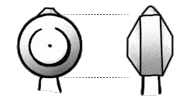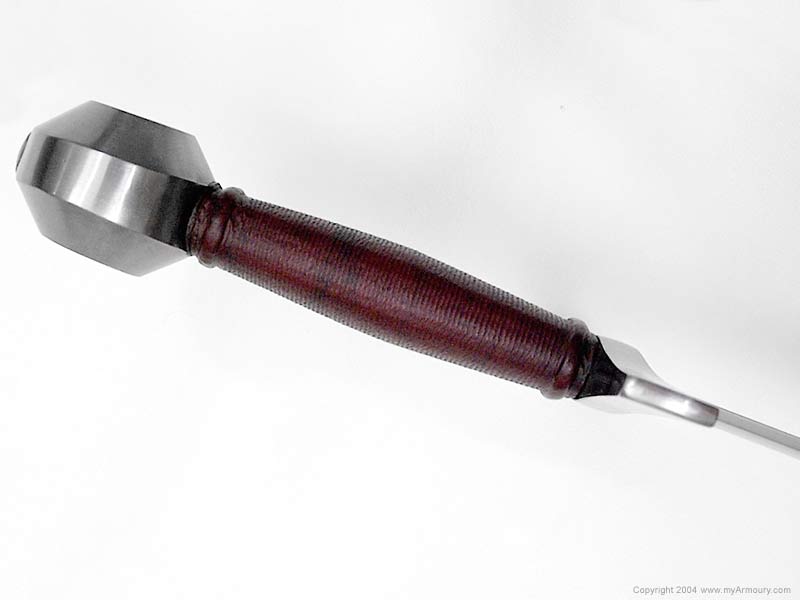| Author |
Message |
|
Jeremy V. Krause
|
 Posted: Fri 27 Apr, 2007 8:18 am Post subject: Question for Peter Posted: Fri 27 Apr, 2007 8:18 am Post subject: Question for Peter |
 |
|
Hi Peter,
I have been wondering about the historical inspiration of the NG Templar. I really love my Templar but I am not as sure as to it's historical origins as I am of my other Albion's. To me the chamferred wheel pommel and type 5 cross seem to be from the early to mid 13th. century while the type Xa blade seems more typical of the early to mid 12th. century. Did you intend this to be an example of an earlier blade mounted on a later hilt, or am I missing something? In any case I really love the long and less tapering blade and especially the deep fuller.
Thanks for your time and keep up the great work!
Jeremy
|
|
  |
 |
Dan Dickinson
Industry Professional

|
 Posted: Fri 27 Apr, 2007 12:48 pm Post subject: Posted: Fri 27 Apr, 2007 12:48 pm Post subject: |
 |
|
I also had a question about the Templar's pommel. On Albion's site it's listed as a type H and in the concept drawing it appears as such...but on the production model it certainly appears to be a type I (and is listed as such in Chad Arnow's review). Did the type change between the drawing and hilt-wax carving and was never updated on the site or is there some reason for classifying it a H ?
Thanks,
Dan
|
|
  |
 |
Chad Arnow
myArmoury Team


|
 Posted: Fri 27 Apr, 2007 12:54 pm Post subject: Posted: Fri 27 Apr, 2007 12:54 pm Post subject: |
 |
|
For reference, here are line drawings of the two pommel types, from our Ewart Oakeshott article:
Type H:

Type I:

The Templar's pommel:


ChadA
http://chadarnow.com/
|
|
    |
 |
Dan Dickinson
Industry Professional

|
 Posted: Fri 27 Apr, 2007 7:53 pm Post subject: Posted: Fri 27 Apr, 2007 7:53 pm Post subject: |
 |
|
Thanks for posting that Chad, it illustrates my point....why call it a type H on Albion's site?
Dan
|
|
  |
 |
Robin Smith

|
 Posted: Fri 27 Apr, 2007 8:53 pm Post subject: Posted: Fri 27 Apr, 2007 8:53 pm Post subject: |
 |
|
Pronounced peening block maybe? Seems the I, atleast in the line drawing has one...
A furore Normannorum libera nos, Domine
|
|
   |
 |
Chad Arnow
myArmoury Team


|
 Posted: Sat 28 Apr, 2007 5:01 am Post subject: Posted: Sat 28 Apr, 2007 5:01 am Post subject: |
 |
|
| Robin Smith wrote: | | Pronounced peening block maybe? Seems the I, atleast in the line drawing has one... |
The peening block really doesn't have anything to do with pommel classifications, especially in this case. You could see both types with or without. In this era, they'd likely be without a pronounced rivet block.

ChadA
http://chadarnow.com/
|
|
    |
 |
Chad Arnow
myArmoury Team


|
 Posted: Sat 28 Apr, 2007 5:05 am Post subject: Posted: Sat 28 Apr, 2007 5:05 am Post subject: |
 |
|
| Dan Dickinson wrote: | Thanks for posting that Chad, it illustrates my point....why call it a type H on Albion's site?
Dan |
I have no idea why they choose to call it that. There are plenty of times where our stats and classifications don't match with a maker's. While some of this results from variations due to handcrafting, a good deal of it doesn't. 
I haven't looked, but perhaps there are variations in versions of Oakeshott's pommel typology, as in the blade typology (for instance, Albion calls the Regent a Type XVIIIB - based on typology laid out in SAC; we tend to call it an XVIIIA - based on the later Records typology).

ChadA
http://chadarnow.com/
|
|
    |
 |
|
Peter Johnsson
Industry Professional
|
 Posted: Sat 28 Apr, 2007 8:49 am Post subject: Posted: Sat 28 Apr, 2007 8:49 am Post subject: |
 |
|
Hey guys!
Good to see posts on a sword that was introduced quite some time ago! The Templar was one of the first Next Generation swords added to the line.
Jeremy, I think we have discussed the dating of the Templar before, have we not?
It is not the most typical set up, that is true, but I don´t think it is a haphazard anacronism. Dating of swords is often not an exact science.
Gently flaring bow tie guards can occasinally be found on swords dating to the 12th C, or perhaps even earlier.
Type I pommels (yes, right you are: this is a type I not a type H: thanks for pointing out this mistake!) can also be found early on. Some of the Finnish finds that Dr J Leppäaho has published have chamfered disc pommels that are straddling type H and type I. The dating of these swords is a bit uncertain; they could belong to the 11th C or perhaps the 12th C. The publication I have is not entirely clear on this point.
I have once seen one sword with just this combination of blade, pommel and guard that the Templar has, published in a popular book on medieval arms and armour (This sword was in the back of my mind when I made the final design of the Templar). I am sorry, but I cannot for my life remember just wich one right now. I have been looking through my reference books, but been frustrated with no reward in my search! I promise to return with the title of the book when I find it.
As to the dating of this precise sword, I cannot say. It was the kind of book you would not rely comfortably on the dating of the objects.
To my mind the Templar could be placed in the 12th C, even if it is not one of the most common combinations of its time.
[/i]
|
|
   |
 |
Craig Peters

|
 Posted: Sat 28 Apr, 2007 9:11 am Post subject: Posted: Sat 28 Apr, 2007 9:11 am Post subject: |
 |
|
|
I could be out on this one, but to me, the Templar feels like it would definitely be post 1175 in the 12th c.
|
|
  |
 |
Robin Smith

|
 Posted: Sat 28 Apr, 2007 10:03 am Post subject: Posted: Sat 28 Apr, 2007 10:03 am Post subject: |
 |
|
The type Xa was still in use in the 13th C., although being replaced by later blade styles. I would be quite comfortable with this sword for an early 13th C. persona...
A furore Normannorum libera nos, Domine
|
|
   |
 |
|
Jeremy V. Krause
|
 Posted: Mon 30 Apr, 2007 7:06 am Post subject: Posted: Mon 30 Apr, 2007 7:06 am Post subject: |
 |
|
Thanks Peter for your reply,
I know I posed the question of dating of this sword before but I wanted to go a bit further into your creative thought process and I thank you for indulging me.
So 12th. century it is- I agree with others that it looks to be an early 13th. c. example but I will follow the thinking of Peter. I would actually prefer that this sword be more contemporary to the 12th. c. as it fits better with my collection.
Thanks again Peter- no more pestering about this sword- I swear! 
Jeremy
|
|
  |
 |
|
Peter Johnsson
Industry Professional
|
 Posted: Mon 30 Apr, 2007 7:21 am Post subject: Posted: Mon 30 Apr, 2007 7:21 am Post subject: |
 |
|
| Jeremy V. Krause wrote: | Thanks Peter for your reply,
I know I posed the question of dating of this sword before but I wanted to go a bit further into your creative thought process and I thank you for indulging me.
So 12th. century it is- I agree with others that it looks to be an early 13th. c. example but I will follow the thinking of Peter. I would actually prefer that this sword be more contemporary to the 12th. c. as it fits better with my collection.
Thanks again Peter- no more pestering about this sword- I swear! 
Jeremy |
Jeremy: shoot away with questions :-) Always welcome. Sometimes I can even provide an answer :-)
I was just not sure if I had not already answered this one.
There is nothing saying the Templar could not fit into a 13th C setting also. The blade is beginning to be a bit old fashioned for that period, but not impossible, I think.
Say latter part 12th C earlier part 13th C?
|
|
   |
 |
|
|

